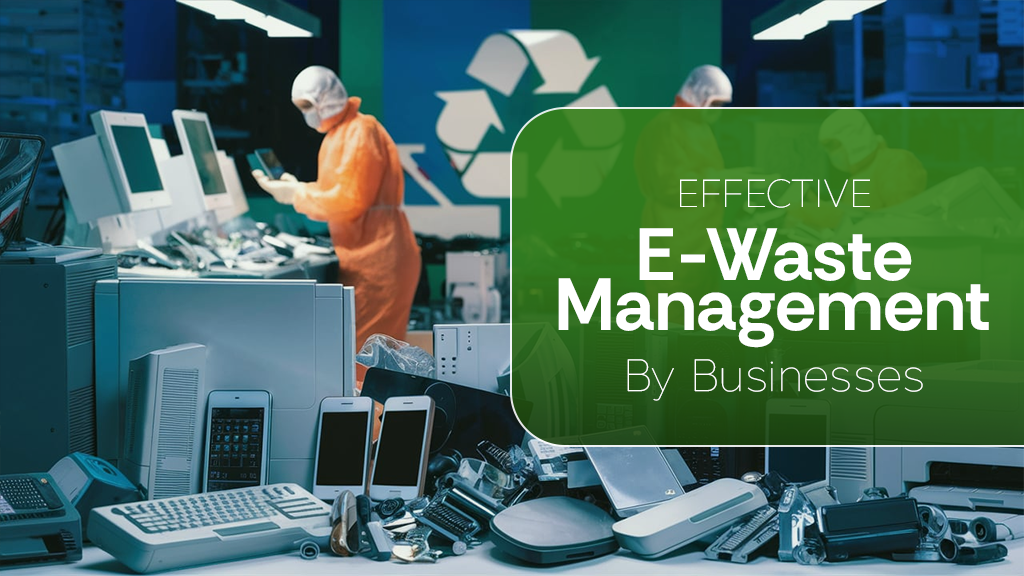In the digital age, businesses rely largely on technological gadgets. From computers and smartphones to office equipment and servers, drives activities in a variety of businesses. However, as these devices reach the end of their useful life, they contribute to a rising environmental issue: e-waste. The improper disposal of electronic waste endangers the environment, and businesses play an important role in adopting an effective e-waste management strategy. This blog will look at how organizations may opt for sustainable e-waste management and the impact of e-waste, using insights from Namo E-waste, a leader in sustainable e-waste solutions.
E-Waste: A Growing Threat to Our Planet
E-waste includes abandoned electronic items such as computers, laptops, televisions, and household appliances. These are a concern to the environment because they emit chemicals like mercury, lead, and cadmium, which contaminate the air, water, and soil, causing major health problems for humans and wildlife.
For businesses, the impact of e-waste is twofold. Not only do companies generate significant volumes of e-waste as they upgrade or replace equipment, but they also have a responsibility to ensure that this waste is managed in an environmentally friendly manner. Addressing e-waste is crucial for reducing environmental harm and fostering a sustainable future.
Why Effective E-Waste Management Matters for Businesses
E-waste management is a lot more than merely an environmental concern; with the digital dependency on gadgets, it has been turning into a significant global and economic challenge as well. As technology advances, the life of electronic devices shortens, and the volume of e-waste rises continuously. Effective e-waste management strategies are vital for businesses to mitigate environmental risks, improve their brand image, and achieve sustainable operations.
Regulatory Compliance: Many countries have rigorous rules in place for e-waste disposal. Failure to comply might result in significant fines and legal ramifications. Implementing an e-waste management strategy assures compliance with these requirements and avoids potential legal implications.
Corporate Responsibility: Companies are increasingly being held accountable for their environmental impact. Sustainable e-waste management improves a company’s reputation as a good corporate citizen, aligns with sustainability objectives, and appeals to environmentally sensitive customers and stakeholders.
Cost savings:
Sustainable e-waste management can lead to cost savings. Recycling and reusing electronic components can reduce disposal costs and potentially recover valuable materials. Additionally, businesses can avoid fines associated with non-compliance, which can be significant.
Creating an E-Waste Management Strategy
Evaluate existing E-Waste Practices: Begin by conducting an audit to determine the amount and types of e-waste produced by your company. Identify gaps in present procedures and potential areas for improvement. This assessment establishes a baseline against which to monitor progress and make informed decisions.
Setting Clear E-waste Management Goals: Set specific targets for your e-waste management program. What do you hope to achieve? Some common goals include minimizing e-waste, increasing recycling rates, and complying with relevant regulations.
Implement Efficient E-Waste Collection Systems: Create internal systems for collecting and categorizing electronic waste. Set up dedicated collecting points inside your business and make them easily accessible. Provide employees with instructions on how to properly dispose of electronic goods and use collection methods.
Partner with Certified E-Waste Recyclers: Collaborate with certified e-waste recyclers, such as Namo E-Waste, to ensure that your electronic trash is treated securely and properly. Certified recyclers follow industry best practices and comply with legislation, giving you peace of mind that your e-waste is being properly processed.
Best Practices for E-Waste Disposal and Recycling
Effective e-waste disposal and recycling are critical to reducing environmental impacts and increasing resource recovery. Here’s how you can do it:
Choose Certified Recyclers: Work with trustworthy recyclers who follow strict environmental guidelines.
Data Security: Make certain that sensitive data is safely wiped or destroyed before recycling.
Material Recovery: Focus on recovering valuable materials like precious metals and rare earth elements.
Reduce, Reuse, and Recycle: Prioritize trash reduction and equipment reuse over recycling.
Regular Monitoring and Reporting:Track and report e-waste volumes and disposal procedures regularly. Monitoring assists in determining the efficacy of your e-waste management strategy and making any changes. Reporting also indicates your organization’s dedication to sustainability and compliance.
Improving and Repairing Equipment: Instead of continually replacing equipment, consider repairing or improving it to extend its life. This method minimizes the quantity of e-waste generated and may be more cost-effective in the long term.
By implementing these steps and partnering with a reputable E-Waste management service, like Namo E-waste, businesses can fulfill their environmental duties and also gain a competitive advantage.
Leveraging Technology and Innovation
Technological improvements have a tremendous impact on improving e-waste management. Advanced recycling technology and customized software solutions can increase efficiency and effectiveness. Namo E-waste blends cutting-edge technology into its services, offering organizations cutting-edge solutions for e-waste management. Businesses that leverage these technologies can remain ahead of regulatory obligations while also contributing to a more sustainable future.
Take Charge of Your E-Waste Today!
In conclusion, E-waste is no longer a mere byproduct of progress but a complex challenge demanding innovative solutions. By understanding the environmental and economic implications, businesses can transform e-waste from a liability into a strategic asset. Through comprehensive audits, robust policies, and strategic partnerships, organizations can effectively manage their e-waste footprint. Embracing technology and prioritizing recycling are pivotal steps towards a sustainable future.
Namo E-waste stands as a committed partner in this journey, as we are a pioneering effort to focus on responsible e-waste management by providing effective and eco-friendly solutions and offering expert guidance and services to help businesses achieve their e-waste management goals. Together, we can build a cleaner, greener tomorrow.


